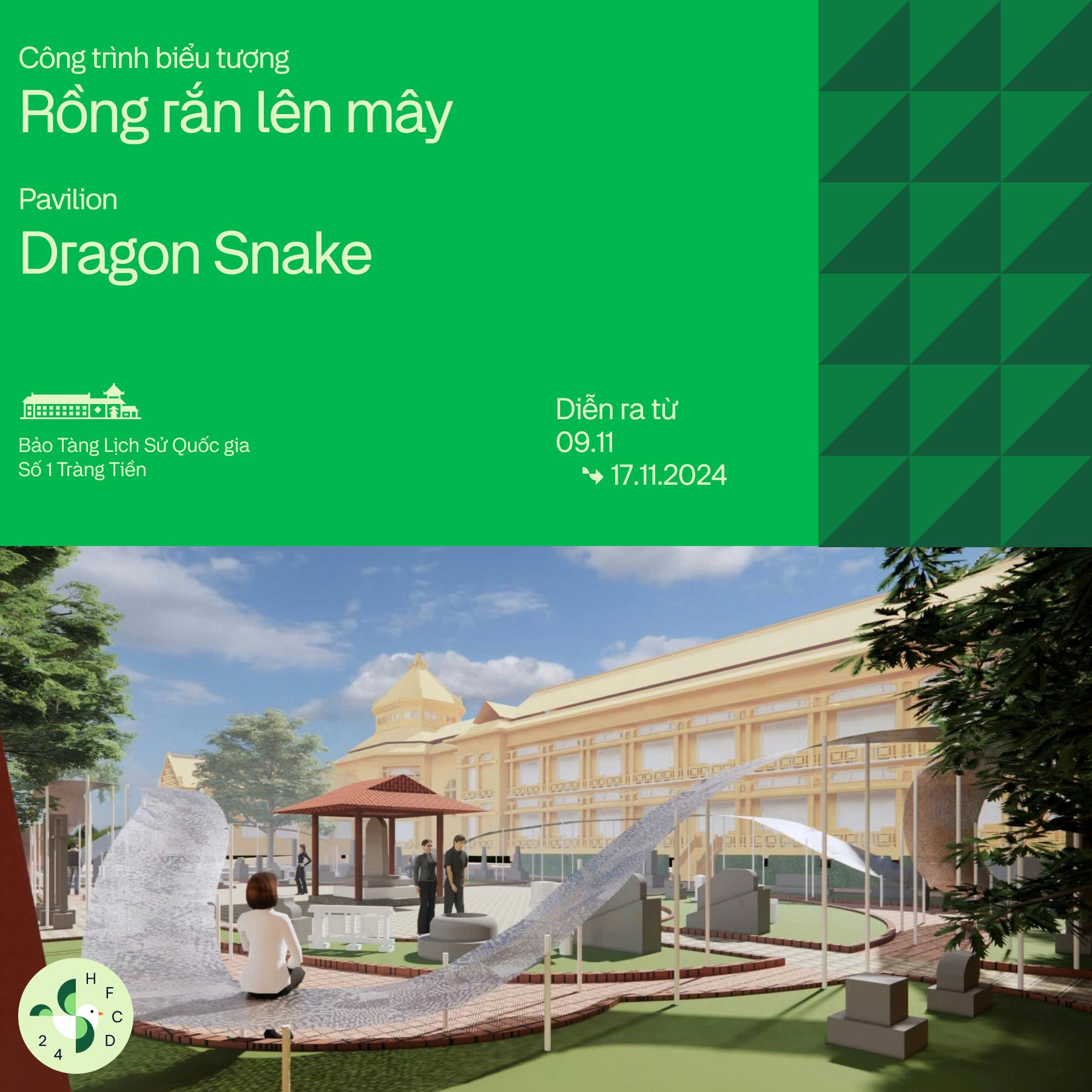Pavilion “Rồng rắn lên mây”

Bảo tàng Lịch sử Quốc gia Việt Nam, trước đây là Bảo tàng Louis Finot thuộc Trường Viễn Đông Bác cổ được coi là một trong những công trình tiêu biểu cho phong cách kiến trúc Đông Dương ở Việt Nam thời thuộc địa, do kiến trúc sư Ernest Hébrard và Charles Batteur thiết kế, là một trong 7 di sản trong trục Giao lộ Sáng tạo của Lễ hội Thiết kế Sáng tạo Hà Nội 2024 năm nay. Tại đây KTS. Nguyễn Công Hiệp và cộng sự từ CA' Library đã thiết kế Pavilion Rồng rắn lên mây như một cuộc đối thoại giữa những yếu tố đương đại với vẻ cổ kính của khuôn viên công trình.

Khác với các Pavilion thông thường nhằm tạo ra điểm nhấn mang tính chất định hướng không gian cho lễ hội, Pavilion Rồng Rắn lên mây được xây dựng với mong muốn trở thành một phần của cảnh quan bảo tàng, không tranh chấp với kiến trúc chính mà tạo ra nơi chốn để thu hút mọi người đến ngắm nhìn công trình di sản này.

Tên gọi Rồng rắn lên mây xuất phát từ hình thái uốn lượn của công trình, là một sự liên tưởng tới trò chơi dân gian có vẻ ít nhiều đã bị lãng quên ở hiện tại. Bằng cách thiết kế và đặt tên này, các KTS vừa mong muốn đem đến một sự uyển chuyển hài hòa về không gian, vừa mong muốn khơi gợi sự thích thú vui chơi và tìm tòi của những thế hệ trẻ, từ đó liên kết với công trình di sản và kho tàng lịch sử đang được lưu trữ và trưng bày trong Bảo tàng Lịch sử Quốc gia. Xen kẽ trong không gian Rồng Rắn lên mây là các tác phẩm sắp đặt “Tỷ lệ có phải là vấn đề?” trưng bày các mô hình công trình Bảo tàng Lịch sử Quốc gia ở các tỷ lệ khác nhau từ 1:20000 tới 1:75 và bằng các chất liệu khác nhau. Người tham gia có thể nhìn ngắm và khám phá dáng vẻ của công trình từ nhiều góc độ để hiểu biết sâu sắc hơn về lịch sử và phong cách kiến trúc của Bảo tàng.

Bên cạnh đó, hầu hết các vật liệu xây pavilion được tái sử dụng các tấm inox gương từ Pavilion tên là "Bến chờ" ở Lễ hội Thiết kế Sáng tạo Hà Nội năm 2023 tại Nhà máy xe lửa Gia Lâm. Việc tái sử dụng các vật liệu cũng nằm trong ý tưởng của các KTS là chuyển tải xu hướng sáng tạo tái tạo trong tương lai.
Pavillion Rồng Rắn lên mây đặt trong khuôn viên Bảo tàng Lịch sử Quốc gia hứa hẹn là một địa điểm vừa vui chơi, vừa khám phá và nhìn ngắm lịch sử phù hợp với nhiều lứa tuổi, nhiều thế hệ.
Vui lòng tham khảo website lehoithietkesangtao.vn trước khi đến để có nhiều hơn các thông tin đa dạng về Lễ hội năm nay!






-----------
The Vietnam National Museum of History, formerly the Louis Finot Museum of the École française d’Extrême-Orient, is considered one of the exemplary structures of Indochine architecture in colonial Vietnam. Designed by architects Ernest Hébrard and Charles Batteur, it stands as one of the seven heritage sites along the “Creative Intersection” axis of the Hanoi Festival of Creative Design 2024. At this venue, architect Nguyen Cong Hiep and his team from CA’ Library have crafted the “Dragon Snake” Pavilion, initiating a dialogue between contemporary elements and the historic ambiance of the museum’s grounds.
Unlike conventional pavilions designed to serve as a spatial focal point for festival, the Dragon Snake Pavilion was constructed with the intention of becoming a harmonious part of the museum landscape. Rather than competing with the main architecture, it creates a space that draws people in to appreciate this heritage structure. The name Dragon Snake comes from the pavilion’s undulating form, evoking a traditional folk game that has somewhat faded from memory in contemporary times. Through this design and name, the architects hope to achieve a graceful spatial integration while sparking playful curiosity and exploration among younger generations, thus fostering a connection to the heritage site and the historical treasures preserved and displayed at the Vietnam National Museum of History. Interwoven within the Dragon Snake space are installations titled ‘Does Scale Matter?’ which showcase models of the National Museum of History at various scales, from 1:20,000 to 1:75, using different materials. Participants can view and explore the structure from various angles, gaining a deeper understanding of the museum’s history and architectural style.
Additionally, the pavilion’s construction predominantly utilizes repurposed mirror-finished stainless steel panels from the “Waiting Station” Pavilion, showcased at the 2023’s Hanoi Festival of Creative Design at the Gia Lam Railway Factory. This material reuse reflects the architects’ commitment to promoting sustainable and regenerative design practices. Situated within the museum’s grounds, the “Dragon Snake” Pavilion promises to be an engaging space for play, exploration, and historical appreciation, appealing to visitors of all ages and backgrounds.
Please refer to website lehoithietkesangtao.vn before coming for more diverse information about this year's Festival!